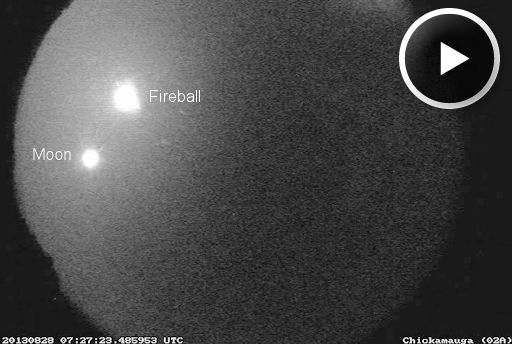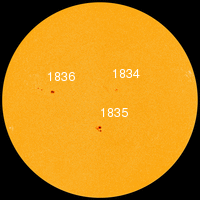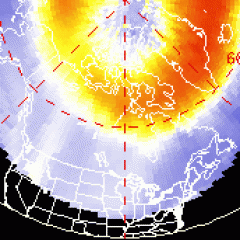~ Space Weather Update~ Incoming CME, Upgraded Fireball [1]
INCOMING CME: A coronal mass ejection (CME, movie [2]) is expected to hit Earth's magnetic field on Sept. 1st, sparking minor to moderate geomagnetic storms around the poles. The CME was propelled toward Earth by a C8-class [3] flare from sunspot AR1836 on August 30th. High-latitude sky watchers, be alert for auroras! Aurora alerts: text [4], voice [5].
MAJOR FIREBALL EVENT, UPGRADED (AGAIN): NASA's Meteoroid Environment Office has upgraded its estimates of a major fireball that exploded over the southeastern USA around 2:30 AM on August 28th. Lead researcher Bill Cooke says "the fireball reached a peak apparent magnitude of -16, about 20 times brighter than a Full Moon, and cast shadows on the ground. This indicates that the meteoroid had a mass of more than 110 kg (240 lbs) and was up to a meter in diameter. It hit the top of Earth's atmosphere traveling 25 km/s (56,000 mph)." Watch the movie, then read more about the fireball below:
"This is the brightest event our network has observed in 5 years of operation," he continues. "There are reports of sonic booms reaching the ground, and data from 4 doppler radars indicate that some meteorites may have fallen along the fireball's ground track [7]." (Note: The city in the ground track map is Cleveland, Tennessee, not Cleveland, Ohio.)
An initial calculation of the fireball's orbit suggested it might be a fragment from a Jupiter family comet. Improved estimates of the orbital parameters point to a different kind of object: a main belt asteroid. If meteorites are recovered from the Tennessee countryside, their chemical composition will tell researchers more about the origin of the fireball.

Solar wind
speed: 408.6 km/sec
density: 3.3 protons/cm3
explanation [8] | more data [9]
Updated: Today at 1507 UT
X-ray Solar Flares
6-hr max: B7 0940 UT Aug31
24-hr: B7 0940 UT Aug31
explanation [10] | more data [11]
Updated: Today at: 1500 UT
![]()
Daily Sun: 31 Aug 13
Sunspot AR1836 poses a threat for M-class [3] solar flares. Credit: SDO/HMI
![]()
Sunspot number: 62
What is the sunspot number? [13]
Updated 31 Aug 2013
Spotless Days
Current Stretch: 0 days
2013 total: 0 days (0%)
2012 total: 0 days (0%)
2011 total: 2 days (<1%)
2010 total: 51 days (14%)
2009 total: 260 days (71%)
Since 2004: 821 days
Typical Solar Min: 486 days
Update 31 Aug 2013
The Radio Sun
10.7 cm flux: 108 sfu
explanation [14] | more data [15]
Updated 31 Aug 2013
![]()
Current Auroral Oval:
Switch to: Europe, USA, New Zealand, Antarctica
Credit: NOAA/POES
![]()
Planetary K-index
Now: Kp= 2 quiet
24-hr max: Kp= 4 unsettled
explanation [17] | more data [18]
Interplanetary Mag. Field
Btotal: 4.2 nT
Bz: 0.9 nT south
explanation [19] | more data [20]
Updated: Today at 1507 UT
![]()
Coronal Holes: 31 Aug 13
Solar wind flowing from the indicated coronal hole should reach Earth on Aug. 31-Sept. 1. Credit: SDO/AIA.



